Nobody looks forward to hearing that they need a tooth extraction, but 74% of British adults undergo this common dental procedure at some point in their lives.
There are a number of reasons why a dentist may recommend having a tooth removed:
- Tooth infection or severe decay
- Periodontal (gum) disease
- Irreparable damage from trauma
- Impaction (in the case of wisdom teeth)
- To make space for tooth realignment with an orthodontic appliance
- To allow dentures or implants to be fitted
In this guide we'll explain what to expect when you have a tooth out. Many people worry about tooth extraction pain, but the good news is that modern anaesthetic techniques make it as comfortable as possible. You'll feel a bit sore afterwards, but we have some advice for aiding healing and recovery after an extraction.
If you don't have an emergency, but you would like to chat with a certified dentist right now online, visit JustAnswer!
Their dentists are based in the US and are available 24/7 to help you out.
In This Article
Reasons for a dental extraction
Let's look first at the main reasons why a dentist may extract a tooth. You can discuss your situation with your dentist to get his or her professional opinion on the condition of your teeth. The tooth extraction procedure is not reversible, so be sure to raise any doubts you have before going ahead.
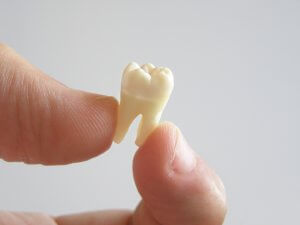
There can be many reasons why a tooth has to be pulled and the news can come as a shock to patients. While preserving your natural tooth is always the goal, sometimes the damage is too severe and it can't be saved through other treatments. In these cases, tooth extraction is the best solution.
Gum disease, tooth decay, or injury can affect oral health so severely that there is no other choice but to pull one or more teeth. Other times, a healthy tooth may need to be removed as a part of an overall orthodontic or oral surgery treatment plan.
The procedure does not hurt because of the use of a local anaesthetic and/or IV sedation and teeth can always and should always be replaced with a dental implant or other solution.
Dr Marshall Kurtz, Greater Connecticut Oral & Dental Implant Surgery
Infection or damage
Thanks to recent advances in dentistry, infected tooth removal is seen as a last resort. Many cases of decay can be treated simply with a tooth filling. Even if you have developed a dental abscess as a result of tooth infection, root canal treatment can often preserve the tooth.
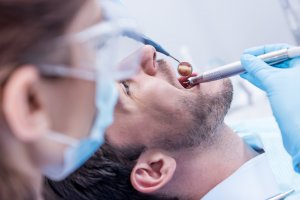
It is also possible to use antibiotics for tooth infection but if the infection persists, it will be necessary to extract it to stop the infection from spreading through the bloodstream to other parts of the body. Equally, dead teeth may need to be extracted to avoid damage to neighbouring teeth.
Where a large part of the tooth is missing due to tooth decay or injury, your dentist may be able to fit a crown. However, if not enough healthy tooth is left to support reconstruction, it will have to be removed.
If you have an accident that loosens your teeth or you find yourself with sudden and severe tooth pain, make an out-of-hours dental appointment. The dentist may perform an emergency extraction or other treatment, but they might just administer sufficient pain relief and advise you to make an emergency appointment with your regular dentist.
Wisdom tooth extraction
Wisdom teeth, also known as ‘third molars', cause problems for many people because our mouths simply don't have space to accommodate them.
When a tooth doesn't push through the gum properly because of overcrowding, it's known as ‘impaction'. A tooth can be fully impacted (completely covered by gum) or partially impacted (only part of it has emerged).
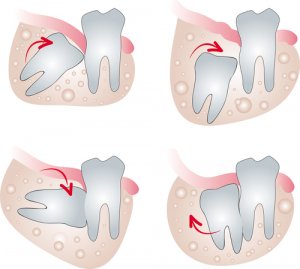
You're likely to experience wisdom tooth pain if one is pushing up against the tooth next to it, and this may ultimately damage the healthy tooth. In this case, it's probably best to have a wisdom tooth extraction.
Another common reason for third molar tooth extraction is decay. Because these teeth are so far back in our mouths, they're often very difficult to clean. This means they are more susceptible to tooth decay. Even if the decay isn't causing any pain, it can eventually spread to the adjacent tooth if the wisdom tooth remains in place.
Not everyone has a full set of four wisdom teeth – and some fortunate people have none at all. But if you do have one or more of your third molars, the chances of complications at some point in your life are fairly high.
Upper wisdom tooth extraction can be easier than with lower ones because upper roots are often fused together, creating a smaller surface area and smoother shape. However, upper wisdom teeth usually have three roots compared to just two in lower wisdom teeth.
Periodontal disease
Periodontitis, a severe form of gum disease, may cause teeth to become loose. This is because the disease erodes the tissue and bone surrounding the tooth root, which are responsible for holding the tooth securely in place.
If the condition has not progressed too far, it may be possible to treat it and save the tooth. In more advanced cases, extraction may be the only option for a loose tooth.
Oral rehabilitation
Dentists may remove teeth for oral rehabilitation purposes. For example, a patient may have some remaining teeth with a hopeless prognosis for treatment because of oral or systemic diseases.
In this case, the best way to restore their smile is to remove those remaining teeth and fit a complete denture or full mouth implants. Leaving the damaged teeth in place will compromise the overall treatment outcome.
Teeth straightening
If you're getting braces to correct tooth misalignment, you might first need to have one or more teeth removed. This frees up some space in your mouth for your other teeth to move into.
You might not need to have any teeth out before having braces, but this will depend on the current state of your teeth as well as the type of braces you choose. With Invisalign invisible braces, for example, it's more common to have the sides of your teeth filed slightly to create a small gap between each one.
You'll need to speak to your orthodontist to find out whether your treatment will require any tooth removal.
In the video below one patient explains what it was like to have teeth removed for braces. She offers some handy tips for anyone who might be about to have this done:
Hypodontia and hyperdontia
These are genetic conditions which cause you to have too many or too few teeth.
With hyperdontia, you develop more teeth than normal and the supernumerary teeth usually need to be extracted.
With hypodontia, on the other hand, you are naturally missing one or more teeth. When an adult tooth is missing, the corresponding baby tooth may not ever fall out, because there is nothing pushing it from below. However, baby teeth aren't meant to last a lifetime, so may need to be extracted later on if they become weak or develop a cavity.
How do dentists remove teeth?
Routine extraction
A straightforward extraction can be done in your usual dental clinic under local anaesthetic. This means you shouldn't experience any pain but you will be aware of what is happening.
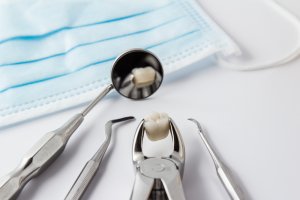
Your tooth root sits in a deep hole in your gum, called a socket. Ligaments hold the tooth root tightly in place – giving your teeth the biting force you're used to.
Most often, dentists use a lever tool called an ‘elevator', which is wedged under the tooth to loosen it. Alternatively, they may have to rock the tooth from side to side to widen the socket. It's not that different to wiggling a tent peg around in its hole to make it easier to remove.
Once the tooth becomes loose, the dentist can pull it straight out with dental forceps. With the anaesthetic blocking any pain, you will just feel some pressure in your mouth during this process. A simple extraction should only take a few minutes.
If you feel very nervous about having a tooth out, ask your dentist if you can have dental sedation for the procedure. This will make you feel calm and relaxed and you won't remember much about it afterwards.
Surgical extraction
Third molar removal, especially in the case of impaction, may require a more complicated surgical extraction. The dentist or oral surgeon has to cut into the gum to access the tooth. Larger teeth might be cut into smaller pieces to make them easier to remove.
The video animation below shows methods for extracting wisdom teeth at various levels of impaction. The same type of elevator tool is used as in a simple extraction.
Tooth extraction under general anaesthetic
Most extractions, even surgical ones, can be done under local anaesthetic. This means you are awake for the procedure but you won't feel any pain. However, more complex cases may need to be performed under general anaesthetic, by a dental surgeon in a hospital. In this case, the whole procedure takes place after you have been put to sleep.
Child tooth extraction under general anaesthetic is more common, especially if several teeth need to be removed. This makes the process less traumatic for the child since they won't remember any of it. Adults who need to have multiple teeth extracted may also choose to do so under general anaesthetic (although NHS patients may not get this choice). This means going to hospital for the treatment but recovery will be much the same.
Another reason you may need a surgical procedure rather than a simple extraction is if there is no tooth remaining above the gum line. This might be because of severe decay or perhaps an injury. In this case, the dentist must cut into the gum to access the remaining tooth root.
Cracked or fractured teeth can also be more complicated to extract since there is a risk of them breaking.
Immediate tooth extraction aftercare
As soon as the tooth is out, the dentist will clean the empty socket and make sure no tissue or bone fragments remain. He or she may press down on the sides of the socket to suppress bleeding and to keep the jawbone in the correct shape.
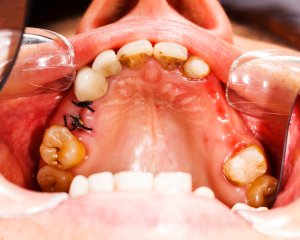
It's at this point that your dentist will places stitches in your gum, if needed. It's normal to get stitches after a surgical incision, and sometimes after a regular extraction. Dentists often use a self-dissolving material which breaks down by itself after a week or so.
Finally, you will be given a piece of folded gauze to bite down on. This absorbs any blood and creates pressure on the extraction site. You may also get an ice pack to minimise swelling. Carefully follow any instructions your dentist gives you with regards to these, as this will aid your recovery.
Does tooth removal hurt?
As we have already mentioned, the local area will be fully anaesthetised. You will feel some pressure – but no pain. The injection to administer the anaesthetic can be a little painful, but your dentist may use a special numbing gel to help with this.
In the unlikely event that you start to feel pinching or pain, alert your dentist immediately. If you're anxious about feeling pain while having a tooth removed, agree in advance a signal you can use to show your dentist that you need to speak.
It's more likely that you'll feel some discomfort or pain after tooth extraction, once the anaesthetic has worn off. You can read more about how to deal with this in the section below on recovery.
How much does tooth extraction cost in the UK?

In the UK, Dental extraction is covered by the NHS band 2 treatment charge. Therefore, an NHS extraction costs £65.20 currently in England, and you can read about other NHS dental charges here. If you are eligible for NHS treatment you will pay this amount for a single course of treatment, which may involve multiple extractions if necessary.
Under-18s, pregnant women and those who have had a baby in the past 12 months receive free NHS treatment. The work may also be free if you need to visit a hospital for the tooth extraction procedure. However, some people struggle to register with an NHS dentist while others prefer to visit a private dentist.
If you pay for a private dental extraction, the cost of removing a tooth will depend on the size and location of the tooth, and how complicated the extraction is.
For example, wisdom tooth extraction costs with a private dentist (and any types of surgical tooth removal) will typically be higher than incisors.
The table below gives an idea of tooth extraction costs in the UK, if carried out at a dental clinic. Do keep in mind that private dental charges vary greatly from one practice to another, so it may be worth shopping around if you need to have several teeth extracted.
[wptb id="20704" not found ]These costs include local anaesthesia but IV sedation, if offered, will incur an additional charge. If you need general anaesthesia for a surgical extraction this will significantly increase the cost of private treatment.
If you need to have teeth removed for braces, this should be included in your overall treatment cost – but it's worth double-checking this to avoid unexpected bills.
Alternatives to tooth extraction
Regardless of whether you are a private or NHS patient, you'll probably find that extraction costs less than alternative treatments such as root canals or crowns. If you're unable to afford the recommended restorative treatment then you may choose the cheaper option of extraction. Whatever your situation, don't try to remove your own tooth to save money.
Removing a tooth should really only be a last resort, though. An empty space in the mouth affects the appearance of the smile and may eventually cause the face to sag. It can also present problems with eating. In the long term, the surrounding teeth are more susceptible to damage and may start to shift position, causing problems with oral hygiene.
As a general rule, it's best to keep your original tooth for as long as possible. If it has to be extracted, it's better to get some kind of replacement tooth rather than leave the gap empty.
Artificial teeth such as dentures, bridges and implants (which you can read more about below) all come at their own cost. In the long run, therefore, it might be more cost effective to preserve the original tooth rather than have it extracted.
So if your dentist feels confident they can perform a root canal treatment or fit a crown to save your tooth, you should seriously consider this rather making a decision based purely on the immediate cost.
Tooth extraction healing process
One thing that many people worry about when it comes to teeth extraction is healing and recovery.
Your dentist will give you advice on what to do after tooth extraction. As this may vary depending on the procedure you had and the position of the tooth, you should follow their instructions first and foremost. Here we have some general information and advice so you know what to expect.
How long does a tooth extraction take to heal?
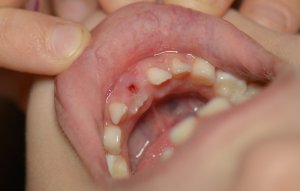
After a tooth is removed, a blood clot forms in the empty socket. It's important to do what you can to keep this clot in place. If the blood clot becomes dislodged the socket is exposed, which is very painful. This condition, known as ‘dry socket', will require additional dental care. You can read about dry socket prevention and treatment in our separate guide.
In simple cases the average tooth extraction healing time is around 7-10 days. After this time the gum tissue is significantly healed and your stitches can be removed (or will dissolve by themselves). Within two weeks, smaller sockets may appear completely healed.
Wisdom tooth extraction recovery can take a little longer, especially if the tooth was impacted and had to be removed surgically. This is simply because the wound from molar tooth extractions is larger and takes longer to heal.
Under the surface, it takes 6-8 months for your jaw bone to grow back and ‘fill in' the hole left by the tooth.
Tooth extraction pain: does it hurt?
It's normal for patients to feel some discomfort, soreness or pain after getting a tooth pulled. Your dentist should give you painkillers to help manage this – or they may recommend suitable over-the-counter products. Alternatively, you can try one of these home remedies for tooth pain to help as you recover.
The area around the socket will probably feel tender and you may experience some swelling in your face.
This discomfort should subside 2-3 days after the extraction. If you continue to experience pain or you suddenly notice the pain worsening several days later, contact your dentist immediately as this could be a result of infection at the extraction site. Yellow or white discharge is also a sign of infection.
Dry socket after tooth extraction

Dry socket (alveolar osteitis) occurs when the protective blood clot fails to form or is dislodged from the socket before it's healed. As a result, the underlying nerves and bone become exposed and food may get lodged in the socket.
This condition is extremely painful and an intense throbbing pain may spread all over the affected side of your face. Pain can begin anywhere between one and five days after the extraction.
Dry socket is a relatively common complication following extraction, particularly with wisdom teeth where the sockets is larger or with difficult extractions. Fortunately, it rarely leads to anything more serious – but you do need to visit your dentist to have it treated. They will give you painkillers and may clean and dress the wound to aid healing.
To avoid developing dry socket after a tooth extraction, follow your dentist's instructions carefully. In particular, smoking is known to increase the risk of dry socket.
Tips for speedy recovery
Giving yourself the right aftercare will help speed up your recovery so you can get back to normal.
In the first 24 hours following removal of a tooth you should:
- Apply gauze as instructed
- Inform your dentist if bleeding doesn't seem to be reducing
- Avoid rigorous rinsing with water or mouthwash
- Avoid brushing the teeth next to the extraction site
- Resist the temptation to poke at the site with your tongue or finger
- Avoid hot foods and drinks, since heat may dissolve the blood clot
- Refrain from smoking, vaping, or drinking through a straw – the sucking action can pull on the clot
- Keep your head elevated when you lie down
- Take it easy and avoid strenuous activities
24 hours after the procedure you can use a salt water rinse for cleaning. Dissolve half a teaspoon of salt in a cup of water and gently swish it around your mouth.
Can I go back to work after a tooth extraction?
Some people feel well enough to return to work immediately after having a tooth removed, whereas others need more time to recover. A lot will depend on how many teeth are extracted and how complicated the procedure is. In any case, it will take an hour or two for any anaesthetic to wear off.
Consider taking a day or two off work to give your body time to rest, especially if you're having a lot of work done or you have a history of slow recovery from medical procedures.
If you have questions about aftercare and returning to work, you can ask a qualified dentist at JustAnswer.
What to eat after a tooth extraction
For a few days afterwards it's best to stick to soft foods and eat on the opposite side of your mouth. If you have had multiple extractions in different locations, your dentist might recommend a liquid diet. You may have to maintain these precautions for up to a week after a surgical extraction.
Keep drinking plenty of water so your body stays hydrated for healing. Just remember not to use a straw, since the sucking action can dislodge the clot in your socket.
Once you have fully recovered, try to maintain good oral hygiene to reduce the chances of you needing another extraction or other dental treatment in the future.
We have an entire article dedicated to what to eat after a tooth extraction if you'd like to know more.
Replacing an extracted tooth
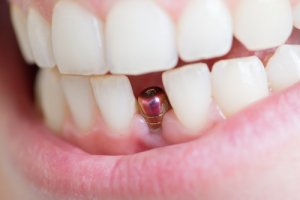
Should you need to have a tooth removed, particularly one at the front, you'll soon be thinking about your options for replacing it. The three main choices are:
- Dentures (false teeth)
- A bridge
- A dental implant
Dental implants are the most permanent option, and also the closest to a natural tooth. The titanium implant is inserted into the jaw bone and an artificial tooth crown is attached on top. The bone fuses with the implant and this minimises bone loss.
But implants are the most expensive option, costing around £2,000 for a single tooth implant and crown. Fortunately, there are ways to save money on the treatment to make implants more affordable.
Bridges and dentures are both types of prosthetic tooth which sit on top of the gum. A bridge is fixed permanently in place while a denture is removable. Both can serve as long-term solutions for missing teeth. The cost of dentures and bridges is much less than implants, but come with a risk of underlying bone loss over time.
You may be able to have an immediate temporary denture fitted straight away if one of your front teeth is removed. Speak to your dentist to find out about a flipper tooth and other options available to you, and how much they will cost.
Yes, there are ways to do this. Some patients are concerned about their appearance when a dentist decides to remove one or more teeth, especially those in the esthetic zone at the front of the mouth. It's understandable that people want to avoid the appearance of a missing tooth.
One of the most common solutions to this problem is immediate dental implants. These can be placed at the same appointment as the extraction, allowing the patient to carry on without worrying about their smile. Dentists have to assess each patient individually to decide whether this is a suitable treatment.
Dr Eyad Tariq
Whatever your current situation, thanks to modern dentistry there are ways to restore your smile and your confidence.
And remember, you can chat with a dentist at any time — 24/7 about your temporary crowns. A team of certified dentists is standing by at JustAnswer.
FAQs
How long does a tooth extraction take?
This depends a lot on which tooth is being extracted, what condition it is in, and whether there are any complications.
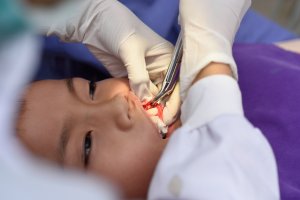
In simple cases, the extraction itself may take only a minute or two, but you need to allow time for the anaesthetic to take effect and for any bleeding to subside afterwards. Therefore the entire process will last more like 20-40 minutes.
Complicated or surgical extractions will take a little longer. Your dentist may have to break the tooth into pieces to remove it, and if the tooth is decayed and cracks or chips then your dentist will need to take extra care to ensure no pieces are left behind. Where stitches are required, this will add a few minutes to the total treatment time as well.
If you're nervous about having a tooth out, ask your dentist to explain the process – including how long they expect it will take. Knowing this information may help you feel calmer.
How long after a tooth extraction can I eat?
You'll probably be safe to eat within a few hours of your extraction, as long as you avoid biting directly on the extraction site and avoid hard, crunchy foods. If you have only had one tooth removed, or multiple teeth on the same side of your mouth, it's not too difficult to just chew on the other side for a while.
Listen to your dentist's advice though, because they may give you specific instructions to follow – especially if you had a complicated extraction.
What can I eat after a tooth extraction?
Most people find it more comfortable to eat soft or liquid foods for at least a day or so while recovering from having a tooth out. Ask your dentist for advice based on your particular condition.
Good foods to eat after a tooth extraction include:
- Smooth soups
- Smoothies
- Mashed potato
- Scrambled egg
- Ice cream
- Jelly
- Yoghurt
Avoid crunchy and chewy foods during this time, and try not to bite down on the extraction site. Also steer clear of acidic and spicy foods – these will hurt if they get into your wound!
Cold foods can help soothe any pain, but be careful if you have sensitive teeth. However, it's best to avoid very hot food and drink for a day or two.
Finally, remember not to drink anything through a straw while your tooth extraction is healing because this can dislodge the blood clot and cause dry socket.
When can I smoke after a tooth extraction?

Your dentist will probably advise you to refrain from smoking for 72 hours after the procedure. You could use this as an opportunity to quit (and help avoid a load more oral health problems in the future). If you don't like the idea of going cold turkey, set yourself up with some nicotine patches so you can still get your fix while your mouth recovers.
As with drinking through a straw, the sucking action of smoking after a tooth extraction can cause the blood clot in your mouth to dislodge. If this happens it can lead to a very painful condition called dry socket – something you'll want to avoid. E-cigarettes carry the same risk, so vaping after a tooth extraction is also a bad idea.
To add to this, toxins in cigarettes can irritate your gums and lead to painful swelling at the extraction site.
Can I drink alcohol after tooth extraction?
Drinking alcohol after a tooth extraction is not a problem in itself, as long as you avoid using straws. However, mixing certain pain medicines with alcohol can be very dangerous.
Also remember that hot and acidic drinks can be painful to consume and prevent proper healing.
Can I drink tea or coffee after a tooth extraction?
You should be safe to drink tea and coffee as soon as your anaesthetic has worn off, unless your dentist tells you otherwise. However, you'll need to avoid hot tea and coffee for a day or two. Hot beverages can interfere with the clotting process. Instead, you'll have to make your drinks iced or lukewarm.
What does an NHS extraction cost?
In England and Wales you will pay the Band 2 treatment charge for an NHS extraction. Prices in Scotland and Northern Ireland vary because they are calculated as a percentage of the total treatment charge. You'll therefore be charged more for a complicated surgical extraction than for a straightforward one.




